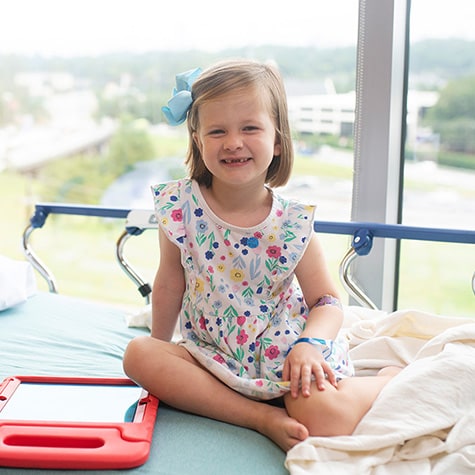Radiology is a type of medical procedure that uses images to determine a patient’s health, and a radiologist is the medical professional who specializes in diagnosing and treating injuries and diseases using these images.
Is radiation safe for kids?
As children grow, their cells divide faster. This puts them more at risk to the effects of radiation. To protect your child, our radiology team uses some of the lowest possible radiation doses in the country. We follow Image Gently guidelines and use special weight- and condition-specific dosing levels to ensure your child receives the lowest radiation dose for the highest-quality scan.
What types of radiology services does Children’s offer?
At Children’s Healthcare of Atlanta, our radiology team goes to great lengths to keep kids safe and families happy while accurately diagnosing illnesses and injuries through our pediatric imaging services. We offer a variety of imaging services, including:
- CT scan: Uses advanced X-ray technology to take cross-sections of your child’s body, called slices. The CT scanner is a doughnut-shaped machine used to view parts of the child’s body that cannot be seen with a regular X-ray.
- Dual-energy X-ray absorptiometry (DEXA): A special pediatric bone scan that uses X-rays to determine the strength of bones. It is the most accurate method of testing bone density using the lowest amount of radiation.
- Fluoroscopy: Uses an X-ray that allows radiologists to view internal organs in motion. The video images are transmitted onto a video monitor.
- Interventional radiology: Uses imaging guidance to perform minimally invasive and targeted treatments, often replacing open surgical procedures.
- MRI: Produces very clear images of the human body using large magnetic radio waves and computers to take pictures of the body.
- Functional MRI (fMRI): A technology that takes advantage of measuring functional skills through the use of MRI technology.
- Intra-operative MRI (iMRI): Produces high-quality images that allow surgeons to better identify tumors and lesions during surgery.
- Nuclear imaging: Uses very small amounts of radioactive materials to diagnose and treat disease by providing information about the structure and function of body parts. In imaging, the radiopharmaceuticals are detected by special types of cameras that work with computers to provide precise pictures of the area of the body being imaged.
- PET scan: Offers physicians a unique view of the body’s organs and tissues because it records body function by showing pictures at the cellular level.
- Ultrasound: Uses sound waves to study hard-to-reach areas of the body. Ultrasound is noninvasive and uses a small probe that is moved over the area of the body being studied. This ultrasound translates the sound waves to create a digital image.
- X-ray: Made by using low levels of external radiation to produce images of the body, the organs and other internal structures for diagnostic purposes. An X-ray provides a picture inside the body by using special radioactive rays. An X-ray can show bones, tissues or parts of organs.

Preparing for your child’s imaging appointment
Research shows that children and parents cope better with medical procedures when they are prepared ahead of time. Here is general information to help you and your child prepare.
LEARN MOREExperience
Children’s is one of the largest pediatric radiology programs in the country, performing more than 300,000 imaging tests each year. This high volume allows our radiologists to see a wide range of cases, resulting in greater diagnostic accuracy for children. By getting the diagnosis right the first time, your child can receive the care he needs sooner.
Expertise
Children are not tiny adults. Their growing bodies and developing minds require specialized care. That’s why our radiologists have received advanced training, so they understand how these differences can impact the diagnosis and care of a child.
Safety
Children’s follows As Low as Reasonably Achievable (ALARA) and Image Gently guidelines to ensure the radiation levels are as low as possible. Each dose is based on the child’s size, area of the body being scanned, diagnosis and history. This allows us to reduce the amount of CT and X-ray radiation your child is exposed to by up to 50 percent compared to adult facilities.
Equipment fit for kids
Children’s was the first pediatric hospital in the U.S. to use special shields that reduce radiation exposure to sensitive body parts. These shields, known as bismuth shields, are made for adults, but our radiology team makes special alterations to each shield so it fits your child perfectly.
Comfort
When a child is nervous, upset or restless—or just very young—he may move too much during an imaging test to get a clear enough picture for doctors to diagnose the child properly. As a result, scans must be repeated. To help relieve anxiety, our imaging rooms are designed to be calming, and our staff has undergone pediatric training to help make kids more comfortable during the procedures. Additionally, some of our centers offer child life specialists or a visit by one of our facility dogs to help calm nerves and distract your child.
Safe sedation
Our team has pediatric-trained sedation specialists who are available to provide medication to help children stay still or relax for their procedures. Our sedation specialists have years of experience at giving the right dose of medication to keep your child comfortable and safe.
Awards and recognition
- Children’s has been named one of the only pediatric Diagnostic Imaging Center of Excellence (DICOE) programs in the country and the only program in Georgia.
- Children’s is accredited by the American College of Radiology (ACR), demonstrating our commitment to quality care and patient safety.
- Children’s is recognized as a Center of Excellence in Pediatric Sedation by the Society of Pediatric Sedation (SPS).
Children’s installs revolutionary low-dose radiation x-ray technology
We are proud to be the first pediatric hospital in the state to offer cutting-edge X-ray imaging technology with 3D modeling for spine or lower body injuries – all while emitting lower radiation. Just one of the ways we are raising the bar to safely care for Georgia’s kids.

Helping make your child as comfortable as possible
When your child has an imaging procedure, he needs to stay still, from a few minutes to a few hours. To help with this, our team may recommend sedation to relax your child or anesthesia to put your child to sleep.
LEARN MOREOur pediatric radiology team, led by Geetika Khanna, MD, Division Chief of Radiology, consists of nearly 30 general radiologists, neuroradiologists and interventional radiologists, as well as approximately 300 technologists and 100 nurses.
Physician leadership
- Adina L. Alazraki, MD, Medical Director of Radiology, Arthur M. Blank Hospital
- Clifford Matthew Hawkins, MD, Director, Interventional Radiology; Medical Director, Vascular Anomalies Clinic
- Leann Linam, MD, Medical Director of Radiology, Scottish Rite Hospital
- Susan Palasis, MD, Medical Director, Neuroradiology
- Amy Mehollin-Ray, MD, Director, Education
- Edward Joseph Richer, MD, Director of Radiology, Hughes Spalding Hospital
- Erica L. Riedesel, MD, Director, Pediatric Radiology Research
General radiology
- Adejimi Adeniji, MD
- Adina L. Alazraki, MD
- Sumera Ali, MD
- Estelle Shelli R Bank, MD
- Mark Bittles, MD
- Kiery Braithwaite, MD
- Joo Cho, MD
- Chelsea Dennison, MD
- Paula N. Dickson, MD
- Marie-Helene Gagnon, MD
- Tae Han, MD
- Lisa Katherine Harris, MD
- Geetika Khanna, MD
- Neil Lall, MD
- Leann Linam, MD
- Jonathan M. Loewen, MD
- Christabell Ndibe, MD
- Amy Mehollin-Ray, MD
- Ashish Parikh, MD
- Edward Joseph Richer, MD
- Erica L. Riedesel, MD
- Bradley S. Rostad, MD
- Nabile M. Safdar, MD
- Stephen F. Simoneaux, MD
- Susan de Witt Taylor, DO
- Thai D. Trinh, MD
- Smyrna Tuburan, MD
Neuroradiology
- John Dennison, MD
- Adam Goldman-Yassen, MD
- Nadja Kadom, MD
- Neil Lall, MD
- Stephen Little, MD
- Susan Palasis, MD
- Kartik Reddy, MD
- Anna Trofimova, MD
Interventional radiology

Arthur M. Blank Hospital
With the opening of Arthur M. Blank Hospital, clinical services at Egleston Hospital, the Emory Children’s Center and the Aflac Cancer and Blood Disorders Center moved to the new hospital.
learn moreWe offer imaging services at our three hospitals in addition to four outpatient locations in metro Atlanta.
Arthur M. Blank Hospital
2220 North Druid Hills Road NE
Atlanta, GA 30329
Scottish Rite Hospital
1001 Johnson Ferry Road NE
Atlanta, GA 30342
Hughes Spalding Hospital
35 Jesse Hill Jr. Drive SE
Atlanta, GA 30303
Children's at Forsyth
The Collection at Forsyth
410 Peachtree Parkway
Cumming, GA 30041
Children's at Satellite Boulevard
2660 Satellite Boulevard
Duluth, GA 30096-5803
Children's at Town Center
625 Big Shanty Road NW
Kennesaw, GA 30144
Children's at Webb Bridge
3155 North Point Parkway
Building A, Suite 100
Alpharetta, GA 30005
Contact Us 404-785-KIDS (5437)
